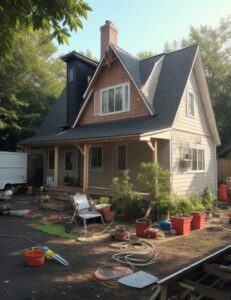One crucial aspect of homeownership that often gets overlooked is regular maintenance. Establishing a home maintenance schedule can save you both time and money in the long run by preventing small issues from turning into major problems.
Monthly Checks
Every month, take a moment to inspect your heating, ventilation, and air conditioning (HVAC) filters. If they’re clogged with dust and debris, replace them. This simple step enhances the air quality in your home.
Give gutters a quick once-over. Remove any debris like leaves and twigs that may have accumulated, ensuring that water can flow freely. Clogged gutters can lead to water damage, so this small effort can save you from significant headaches down the line.
Check your fire extinguishers monthly to ensure they are in good working condition. Confirm that the pressure gauge is within the recommended range, and make sure there are no visible signs of damage or wear.
Seasonal Tasks
 After winter, it’s time to assess the exterior for any wear and tear. Inspect the roof for missing shingles or signs of damage. Check the siding for cracks or gaps that could lead to water intrusion. A thorough examination can prevent minor issues from turning into major repairs.
After winter, it’s time to assess the exterior for any wear and tear. Inspect the roof for missing shingles or signs of damage. Check the siding for cracks or gaps that could lead to water intrusion. A thorough examination can prevent minor issues from turning into major repairs.
Before the summer heat arrives, schedule a professional service for your air conditioning unit. This ensures it operates efficiently when you need it most. Regular maintenance can extend the life of your system and prevent unexpected breakdowns.
As the temperatures drop, shift your focus to the heating system. Schedule a professional inspection to ensure it’s in optimal condition for the colder months ahead. A well-maintained heating system improves energy efficiency.
Prevent frozen pipes by insulating them before winter sets in. This simple task can save you from the inconvenience and potential damage associated with burst pipes. Focus on pipes in unheated or exposed areas, such as the basement or crawl spaces.
Fall is the time to clean the chimney. Creosote buildup can pose a fire hazard, so a thorough cleaning ensures a safer and more efficient use of your fireplace during the winter months.
Quarterly Maintenance
Test smoke and carbon monoxide detectors to ensure they’re in working order, replace batteries if needed, and verify that the alarms are audible throughout your home. These simple checks contribute significantly to the overall safety of your household.
Inspect Windows and doors for any signs of leaks or drafts. Check the weatherstripping and seals, addressing any issues promptly. Maintaining a tight seal keeps your home comfortable year-round.
Enhance the security of your home by checking all locks and security measures. Ensure that all doors and windows have functioning locks, and consider updating or upgrading your security system if necessary.
Bi-Annual Checkups
Conduct a bi-annual roof inspection to identify any missing shingles, signs of damage, or potential leaks. Addressing these issues promptly can prevent water damage and extend the lifespan of your roof.
Assess the foundation of your home for any cracks, shifts, or signs of settling. Foundation issues can lead to serious structural problems if left unattended. Identifying and addressing these concerns early on is important for the stability of your home.
Annual Assessments
Check the attic for any signs of leaks, water damage, or pest infestations. Inspect the insulation to ensure it’s in good condition, as proper insulation contributes to energy efficiency and temperature regulation throughout your home.
Assess the plumbing throughout your home, checking for leaks, water pressure issues, and signs of corrosion. Inspect visible pipes for any signs of wear, and address any plumbing concerns promptly to prevent water damage and ensure the longevity of your plumbing system.
Give your electrical system a thorough once-over. Check for any flickering lights, tripped circuit breakers, or outlets that may feel warm to the touch. If you notice any abnormalities, consult with a professional electrician to address potential issues and ensure the safety of your home.
Evaluate the condition of your appliances, including the refrigerator, dishwasher, and washing machine. Clean filters, check for any unusual noises or performance issues, and address any maintenance needs. Regular appliance maintenance prolongs their lifespan and prevents unexpected breakdowns.
Exterior Maintenance
Check the siding for cracks, peeling paint, or any signs of wear. Addressing these issues promptly protects it from the elements. Consider repainting or touching up areas where the paint is compromised to maintain a protective barrier against the weather.
Maintain your landscaping to enhance curb appeal and protect the structural elements of your home. Prune trees and shrubs around your home to mitigate potential storm-related damage. Regularly clean debris from pathways and driveways to prevent slips and falls. A well-maintained landscape contributes to a positive first impression and protects your property from potential hazards.
Inspect outdoor fixtures such as lights, doorbells, and mailboxes for signs of wear or damage. Ensure that they are securely attached and functioning correctly.
 Consider the specific characteristics and age of your home. Older homes might require more frequent checks, while newer constructions may have different maintenance needs.
Consider the specific characteristics and age of your home. Older homes might require more frequent checks, while newer constructions may have different maintenance needs.
Identify tasks that are time-sensitive or critical for safety. Prioritize these at the beginning of the respective time periods.
Utilize digital calendars, reminders, or home maintenance apps to ensure you don’t miss scheduled tasks.
Evaluate your budget for any professional inspections or services. Allocate resources accordingly, especially for tasks that may require specialized expertise.
Create a physical or digital document outlining your home maintenance schedule. Share it with household members.
Maintain adaptability and be ready to modify your schedule as circumstances require.
Creating a home maintenance schedule may seem daunting, but the benefits far outweigh the effort. By staying on top of regular checks and addressing issues promptly, you create a safe and comfortable living environment for you and your family.